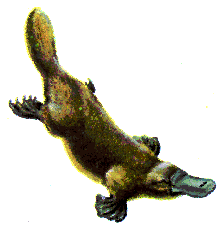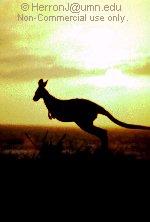
Yagoona
Public School
Parents Education
TTALL Programme Final Project

The very heart and soul of the Aboriginal people can be
found in the many Dreamtime legends and stories. These are their laws,
it is what bonds them to the land, rivers and the animals.
Each tribe has its own 'totem' and that tribe never hunted
that particular animal for food. And remember Aboriginal people NEVER killed
for sport and only killed for food and only when necessary.

The Platypus was not at anytime hunted or eaten. The Aboriginal
people recognised it as a rare species belonging a little to all others
and quite unique. It was taboo in all areas. Dreamtime stories revel the
respect these people had for this unusual creature. The sighting of a platypus
was regarded as a 'good luck' omen.

Kangaroo was the largest of the animals hunted and the
most important. The major source for meat, bones for making implements,
hide used to make water carriers, rugs and cloaks. Babies wrapped in or
lain upon, fur side up.
They had much knowledge and a deep seated respect for
each living creature believing that each one like themselves had its special
place in the overall plan of creation and life.
In 1788 an estimated 300,000 persons lived in this land
and had done so for many thousands of years prior to this. The meat of
the native animals was a major source of food so the animals and birds
were necessarily hunted constantly. Yet in 40, 000 years of Aboriginal
occupation of this land very few animal species became extinct. They practiced
long term conservation very well indeed. They had a policy of take some,
leave some, when raiding birds nests for eggs, they never killed young
animals or a mother suckling young. The walkabout circuit followed the
same route and usually took place in the same seasons of each successive
year. Coastal people did not need to 'move on' as constantly.
For the Sydney Aborigines, the events of 1788 marked the
end of a time during which a rich material and spiritual culture had developed.
The European society established on the shores of Port Jackson not only
had a direct impact on Aboriginal life but also depleted many natural resources
on which it depended.
The first Europeans failed to recognise the relationship
between the Aborigines and the land and to accept that Aboriginal people
had prior claim to it. From the first days of settlement, they established
a pattern of aggression, displacement and neglect.
Although they devoted much time to food gathering and
associated technical processes, their social system allowed frequent contact
between neighbouring bands and larger groupings on ceremonial occasions,
providing opportunities to exchange gifts and settle disputes. There was
time to draw and paint on rock shelter walls and to engrave thousands of
figures on flat sandstone outcrops. There was time to decorate themselves
with clay and ochre for corrobrees and to tell the children stories of
the Dreaming.
Thank You for visiting these TTALLpages
Published August 1997 - Updated December 2007 ©
